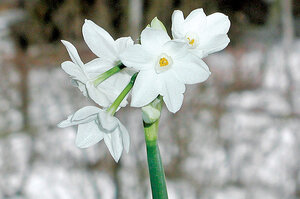Paperwhites’ promise of spring
Pro: They are absurdly easy to grow. Con: Not everyone likes their scent.

Lee Reich/AP
No one argues about how pretty they are, but not everyone agrees about the fragrance of paperwhites, or indoor narcissus. But even if you object to the musky odor (I happen to like it), you certainly can’t object to the effort required to grow them, which is almost no effort at all.
They require no period of cold in order to bloom. They are tender bulbs, hardy only to USDA Zones 8 or 9, which includes the southernmost parts of the country, and the West Coast.
Most paperwhites (Narcissus papyraceus) are white – Ziva is most commonly sold in garden centers – but you can find a half dozen cultivars online, including Grand Soleil d’Or, which has yellow petals and an orange cup. Chinese Sacred Lily and Wintersun have a nonmusky scent. All have multiple stems per bulb, multiple flowers per stem, and thin, blue-green foliage.
(If it’s fragrance you want, buy a pot of Dutch hyacinths, which are widely sold this time of year. Their odor inspires adjectives such as heady, intoxicating, ravishing, and more.)
Like Chia Pets, paperwhites are ready to go when you buy them: Everything they need to bloom is already in the bulb. All we gardeners have to do is fill a container without drainage holes with a couple of inches of well-rinsed gravel or pebbles, or with potting soil. I’ve had good results using gravel, but some say that growing them in potting soil produces longer-lasting flowers.
Crowd the bulbs together, pointed end up, and anchor them in the planting medium with no more than their bottom half covered. Add enough water to reach the base of the bulbs, and maintain the water at that level. Set the container in direct light, such as a south-facing window, where the temperature is between 60 and 65 degrees F. Once flowers appear, move the plants out of direct sun and, if you can, to a cool location.
While I have no complaints about paperwhites’ fragrance, I do have two others: First, they can’t be saved to bloom again. I use “can’t” advisedly, for some gardeners reset them in potting soil, fertilize them well, give the plants plenty of sun until the foliage dies back, then stop watering and allow the bulb to go dormant. They store the bulbs in a dry cool place until repotting them the next November. Chances of flowers? About 1 percent. My advice is to toss the spent bulbs on your compost pile.
Second, paperwhites get leggy and flop over. There are several solutions: Bright light and cool temperatures encourage shorter, stockier stems. Or use a tall, straight-sided container: I use clear-glass vases, 12 to 18 inches tall. You can also mix a little rubbing alcohol into the water you use. Scientists at Cornell University Department of Horticulture’s Flower Bulb Research Program say that using a 5 percent alcohol solution can reduce stem growth by up to half without affecting flower size or number. To determine a 5 percent solution, divide the alcohol percentage (look on the label of the bottle) by 5 and subtract 1. For 70 percent rubbing alcohol, it would be 70 divided by 5, which equals 14; minus 1, which equals 13. So the proportion is 1 part alcohol to 13 parts water. Careful: A 6 percent solution kills the bulbs.
Start the bulbs in water alone. Once the roots have developed and there is an inch or two of green growth – after about 10 days – pour off the water and refill the container with a water-alcohol mix. Continue to water with the water-alcohol solution, just to the bulbs’ bases.
Then bask in the beauty (and fragrance) of these tender daffodils, and their promise that spring – and hardy daffodils – are just around the corner.

